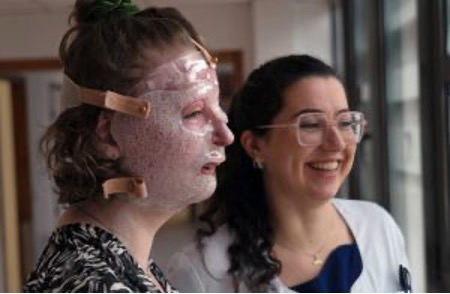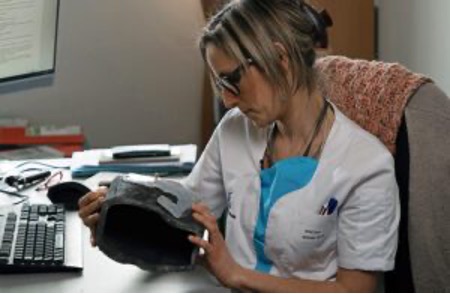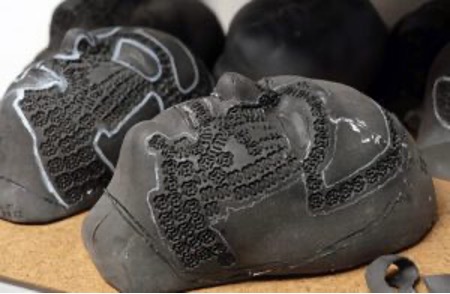These 3D-printed masks could greatly help pediatric burn patients
April 14, 2023
Source: drugdu
 307
307
April 11, 2023 By Jim Hammerand Leave a Comment

Burn patients wear the masks on their face to heal scars and prevent complications. “I almost prefer to have the mask on,” said patient Laura Weibel (pictured on the left). [Photo courtesy of Formlabs]
3D-printed masks are removing a traumatic part of treatment for children recovering from severe burns.
At Romans Ferrari pediatric rehabilitation center in France, a child with facial burns previously would need to sit motionless for a plaster cast of their face to make a mask for treatment. The masks compress the skin to help scars heal without complications, but the heat from warm plaster bandages can make young burn victims uncomfortable — or worse.
“It required the patients to be motionless for the duration of the plaster cast that lasts about half an hour, which can be difficult, especially for children, and could reactivate symptoms of post-traumatic stress disorder,” said Dr. Sara Arias in a Formlabs blog post.

Centre Romans Ferrari Dr. Sara Arias [Photo courtesy of Formlabs]
The team has now treated more than 100 patients by digitally scanning their faces and 3D printing mask molds in-house using a Formlabs Fuse 1 selective laser sintering (SLS) printer.
The 3D scanning and printing technology allows for specialized reliefs that can better treat a patient’s individual scars than traditional compression masks.
“3D printing is something we’ve dreamed of for quite a long time,” Romans Ferrari GM Christophe Debat said. “We had imagined that a 3D printer would allow us to produce a mask based on the scanned file without ever having to touch the patient.”
Related: Could this 3D printing method create bone-like ortho implants?
How the idea came to be
Debat credited Jean-François Veauville, a Romans Ferrari board member, with getting the technology into use. The former aeronautical construction engineer tasked engineering students at École Centrale de Lyon to study whether 3D printing could be used to make the masks or improve the process.
The students evaluated and tested 3D printing products and how to digitize the entire process, working with equipment integrator 3DZ France.
“The real difficulty was to understand what the practitioners were expressing and to transform the medical language into technical language because we have different lexicons,” 3DZ France CEO Patrick Ferraris said. “The first challenge was to relieve the child in the process of capturing the scanning data. Second, to have a solution that is easy to deploy and can be quickly learned at the practitioner level.”
The 3D-printed mask mold process and final product

These 3D-printed mask molds with reliefs for scar treatment are created from digital scans of a patient’s face. [Photo courtesy of Formlabs]
The process starts by 3D scanning a patient’s face and designing a mask with CAD software. Instead of covering the patient’s face with plaster, a doctor gently marks key relief locations on the patient’s face, and then the technician adds those engraved details to the design with a digital pen.
“It is necessary to place these reliefs of different shapes in a very precise way on the scar according to the zones which need it,” Arias said.
They then 3D print the mask mold with silicone and use a transparent plastic sheet to thermoform the final mask that the patient will wear on their face.
The masks take some getting used to, said Laura Weibel, a patient at the center who has been wearing the mask daily for more than a year after some initial itchiness.
“I almost prefer to have the mask on … I really see the difference because a year ago my skin was not like this at all. I was redder, puffier, and much more rigid,” she said.
Spreading the technology

A transparent plastic sheet is thermoformed over the mold to make the mask. [Photo courtesy of Formlabs]
Romans Ferrari treats about a quarter of severe pediatric burn patients in France. The new 3D-printed mask mold technology makes it possible for the center to take scans sent by doctors elsewhere and ship them finished masks.
They’ve already made at least one mask for a child in Jordan through Doctors Without Borders and are hoping to help more patients through new partnerships.
“Due to our extensive experience, we aim to provide this technique to all patients, as the methods and tools we produce are unique and far more efficient than those available elsewhere,” Debat said. “The idea is to be able to find partners with whom we will have the scanner, the doctor who will design the medical devices, and we manufacture them at cost, so others can also benefit from this innovation.”
By editorRead more on
- Breaking the Mold and Forging a New Path! From Insulin Technology Pioneer to Global Innovation Competitor December 4, 2025
- A subsidiary of Kingfriend Pharmaceutical Co., Ltd. has received FDA approval for its self-developed injectable dapavancin December 4, 2025
- Major ophthalmic new drug successfully completed Phase III trials December 4, 2025
- Simcere Pharmaceutical and Wangshan Wangshui have reached an exclusive licensing agreement for deuterium remidevir hydrobromide for new indications such as RSV infection December 4, 2025
- SAL0140 tablets approved for clinical trials for the treatment of chronic kidney disease December 4, 2025
your submission has already been received.
OK
Subscribe
Please enter a valid Email address!
Submit
The most relevant industry news & insight will be sent to you every two weeks.



